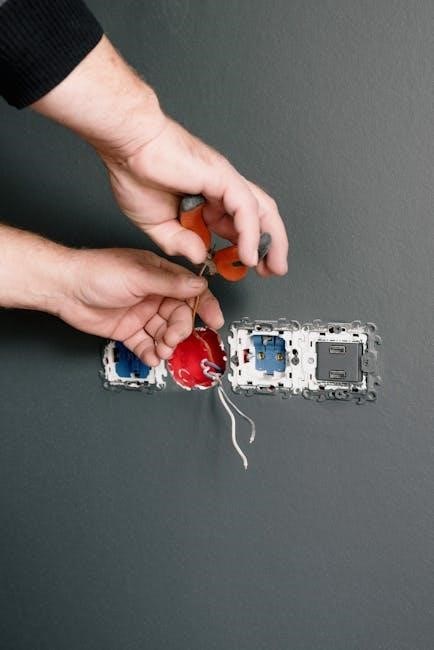AS/NZS 3000 Wiring Rules: 2022 Update and Key Aspects
The AS/NZS 3000:2018 Wiring Rules, with Amendment 3 released in 2022, are essential for electrical installations. These rules specify safety requirements for design, construction, and verification in Australia and New Zealand. This standard defines new terms and clarifies existing ones, ensuring consistent understanding and application across the industry.

The AS/NZS 3000, also known as the Australian/New Zealand Wiring Rules, serves as the cornerstone for electrical installations in both countries. This standard outlines the mandatory requirements for the design, construction, and verification of electrical systems, ensuring safety and compliance across various premises and land. It is regularly updated to incorporate new technologies, improved installation techniques, and address emerging safety concerns.
The wiring rules are essential for electricians, inspectors, and regulatory bodies, providing a comprehensive framework for electrical work. Compliance with AS/NZS 3000 is not only a legal requirement, starting on January 1, 2019, but also a critical aspect of ensuring the safety of individuals and property. This standard specifies the selection and installation of electrical equipment, forming an integral part of electrical installations.
AS/NZS 3000 aims to mitigate electrical hazards and promote safe practices within the industry. The standard is continuously revised to reflect advancements in electrical engineering and address feedback from industry stakeholders. Understanding and adhering to the AS/NZS 3000 Wiring Rules is paramount for anyone involved in electrical work in Australia and New Zealand.
Availability and Accessing the Standard
Accessing the AS/NZS 3000:2018 Wiring Rules, including Amendment 3:2022, is crucial for electricians, inspectors, and anyone involved in electrical work. The standard is available for purchase through SAI Global, a primary distributor of Australian and New Zealand standards. Purchasing the standard ensures you have the most up-to-date and complete version for compliance.
For accredited businesses, access may also be available through industry associations like the Caravan Industry Association of Australia and platforms like i2i. These platforms provide a convenient way to view and download the standard if your organization is already a member.
The standard is typically offered in various formats, including hardcopy and PDF. The PDF format allows for easy searching and portability, while the hardcopy provides a physical reference. Some providers also offer different user licenses for the PDF version, accommodating various business needs.
Keep an eye out for updates and revisions to ensure you are always working with the latest version of the Wiring Rules. Regularly checking SAI Global or relevant industry websites will help you stay informed about any amendments or new editions.
Key Changes and Amendments in AS/NZS 3000:2018 Amd 3:2022
The AS/NZS 3000:2018 Amd 3:2022 introduces several key changes and amendments to the wiring rules. One significant aspect is the definition of new terms like “accessible,” “alteration,” and “arc fault detection device (AFDD),” ensuring clarity and consistent interpretation; Clarifications have also been made to terms such as “outbuilding – individual” and “outbuilding – combined,” reducing ambiguity in application.
These amendments reflect advancements in technology, improved installation techniques, and a focus on enhanced safety. Electricians, inspectors, and regulators must understand these changes to ensure compliance. The updates address evolving industry practices and aim to minimize risks associated with electrical installations.
The amendments are essential for all electrical work carried out after the implementation date. Familiarizing oneself with these changes is crucial for anyone involved in the design, construction, and verification of electrical installations in Australia and New Zealand. Staying up-to-date with these amendments ensures adherence to the latest safety standards.
Definition of New Terms: Accessible, Alteration, AFDD
The AS/NZS 3000:2018 Amd 3:2022 introduces crucial new definitions to enhance clarity and precision in electrical installations. The term “accessible” refers to the ability to reach or expose an item, often for maintenance or inspection, without damaging the building structure or finish. This definition impacts how electrical components are installed and maintained.
“Alteration” defines any changes or modifications to an existing electrical installation, distinguishing it from new installations or repairs. Understanding this definition is vital for ensuring that any modifications meet current safety standards. It also affects requirements for RCD protection during alterations.
The definition of “Arc Fault Detection Device (AFDD)” is particularly important. AFDDs are designed to detect and mitigate arc faults, which are a common cause of electrical fires. The inclusion of AFDDs reflects a focus on improving fire safety in electrical installations, offering enhanced protection against potential hazards. These new definitions ensure consistent application of the wiring rules.
Clarification of Terms: Outbuilding ─ Individual and Combined
AS/NZS 3000:2018 Amd 3:2022 provides vital clarification on the terms “outbuilding ─ individual” and “outbuilding ⏤ combined” to ensure correct application of wiring rules in diverse settings. An “outbuilding ─ individual” refers to a separate structure on a property that is not directly connected to the main building. This includes sheds, garages, or workshops that have their own electrical supply. Understanding this definition is crucial for determining appropriate wiring and protection measures for such structures.
An “outbuilding ⏤ combined,” on the other hand, refers to multiple outbuildings that are electrically interconnected or share a common electrical supply. This could include a series of sheds or workshops linked to a single distribution board. The distinction is important because combined outbuildings may require different safety measures and earthing arrangements compared to individual outbuildings.
These clarifications help electricians and inspectors accurately assess and apply the relevant wiring rules, ensuring safety and compliance in all types of electrical installations.
Mandatory Implementation and Importance
The mandatory implementation of AS/NZS 3000, including the 2022 amendments, is crucial for ensuring electrical safety across Australia and New Zealand. Effective from January 1, 2019, these wiring rules set the standard for electrical installations in all premises. Compliance is not just a recommendation; it’s a legal requirement for electricians, inspectors, and regulatory authorities.
The importance of adhering to these rules cannot be overstated. They are designed to minimize the risk of electrical hazards, protecting people and property from potential harm. By specifying requirements for design, construction, and verification, AS/NZS 3000 ensures that electrical installations are safe, reliable, and fit for purpose.
Regular updates and amendments, such as the 2022 revisions, keep the standard current with technological advancements and improved installation techniques. This ongoing process guarantees that electrical work is performed to the highest safety standards, reducing the likelihood of accidents and promoting a safe electrical environment for everyone.

Scope and Application of the Wiring Rules
The AS/NZS 3000 Wiring Rules define the requirements for electrical installations, covering a broad scope of applications. These rules apply to the design, construction, and verification of electrical systems in various premises across Australia and New Zealand. They are essential for ensuring safety and compliance in electrical work.
The wiring rules encompass a wide range of electrical installations, including residential, commercial, and industrial settings. They provide specific guidelines for selecting and installing electrical equipment, wiring methods, and protection devices. By adhering to these standards, electricians and installers can ensure that electrical systems are safe, reliable, and efficient.
Furthermore, the AS/NZS 3000 Wiring Rules are continuously updated to reflect changes in technology and industry best practices. The 2022 amendments, for example, introduce new definitions and clarifications to enhance the clarity and applicability of the standard. This dynamic nature ensures that the wiring rules remain relevant and effective in addressing emerging challenges in the electrical industry.
Compliance and Enforcement
Adherence to the AS/NZS 3000 Wiring Rules is not merely a recommendation but a mandatory requirement for all electrical installations in Australia and New Zealand. Compliance ensures the safety of people and property by mitigating the risks associated with electrical hazards. Regulatory authorities and electrical distributors actively enforce these rules to maintain a high standard of electrical safety.
Enforcement mechanisms include inspections, audits, and certifications to verify that electrical work meets the standards set out in AS/NZS 3000. Electricians, inspectors, and regulatory bodies play crucial roles in upholding these standards. Non-compliance can result in penalties, rework, or even legal action, underscoring the importance of understanding and following the wiring rules.
Moreover, compliance with AS/NZS 3000 contributes to the overall reliability and longevity of electrical installations. By adhering to the prescribed guidelines, electrical systems are less prone to faults, reducing the risk of downtime and costly repairs. Therefore, compliance is not only a legal obligation but also a sound business practice that benefits both installers and end-users.
Periodic Assessment: AS/NZS 3019:2022
AS/NZS 3019:2022 outlines the requirements for the periodic assessment of electrical installations, ensuring their continued safety and compliance with the AS/NZS 3000 Wiring Rules. This standard provides guidelines for evaluating the condition of electrical systems over time, identifying potential hazards, and recommending necessary maintenance or upgrades. Regular assessments are crucial for maintaining the integrity of electrical installations and preventing accidents.
The periodic assessment process involves a thorough inspection of various components, including wiring, switchboards, protective devices, and earthing systems. The assessment aims to identify any deterioration, damage, or non-compliance issues that may compromise safety. AS/NZS 3019:2022 specifies the frequency of assessments based on the type of installation and its operating environment.
Following the assessment, a detailed report is prepared, outlining the findings and recommendations. This report serves as a valuable tool for planning maintenance activities and prioritizing repairs. By adhering to AS/NZS 3019:2022, property owners and managers can ensure the ongoing safety and reliability of their electrical installations, minimizing the risk of electrical incidents.
Impact on Electrical Installations
The AS/NZS 3000:2018 Amd 3:2022 significantly impacts electrical installations by introducing updated requirements and clarifying existing ones. These changes affect the design, construction, and verification processes, ensuring enhanced safety and compliance. Electricians and installers must adapt to these modifications to meet the current standards.
One key impact is the introduction of new definitions, such as “accessible” and “alteration,” which provide clearer interpretations of the rules. This reduces ambiguity and promotes consistent application. The mandatory implementation of the wiring regulations from January 1, 2019, emphasizes the importance of adhering to the updated standards.
Furthermore, the standard impacts the selection and installation of electrical equipment, ensuring it meets safety requirements. Compliance with AS/NZS 3000 is essential for all premises in Australia and New Zealand, as enforced by regulatory authorities. Periodic assessments, as per AS/NZS 3019:2022, are crucial for maintaining the integrity of electrical installations and ensuring ongoing compliance with the wiring rules. The updates ultimately contribute to safer and more reliable electrical systems.
Specific Requirements for RVs (AS/NZS 3001.2:2022)

AS/NZS 3001.2:2022 outlines specific electrical safety requirements for recreational vehicles (RVs), including caravans, motor homes, and camper trailers. This standard addresses unique challenges associated with electrical systems in mobile environments, ensuring the safety of occupants and equipment. It complements AS/NZS 3000 by providing additional requirements tailored to RV installations.
The standard covers various aspects of electrical systems in RVs, such as wiring methods, protection devices, and earthing arrangements. It aims to minimize the risk of electric shock, fire, and other hazards. Compliance with AS/NZS 3001.2:2022 is essential for RV manufacturers, installers, and owners to ensure the safety and reliability of electrical installations in these vehicles.
Key considerations include the selection of appropriate electrical components, proper installation techniques, and regular maintenance. The standard also addresses the connection of RVs to external power sources, such as caravan parks, ensuring compatibility and safety. By adhering to AS/NZS 3001.2:2022, stakeholders can create safer and more compliant electrical systems in RVs.
Maximum Demand Calculation

Calculating maximum demand is crucial in electrical installations to ensure the system can safely handle the anticipated load. AS/NZS 3000 provides guidelines for determining maximum demand, which involves assessing all potential loads within an installation. This calculation helps in selecting appropriate cable sizes, protective devices, and transformer ratings.
The process involves identifying various load groups, such as lighting, power outlets, and fixed appliances. Each load group is assigned a demand factor, which represents the percentage of the total load expected to be in use simultaneously. These demand factors vary based on the type of load and the diversity of usage.
For residential installations, factors like dwelling size and appliance types influence the calculation. For commercial and industrial settings, factors like equipment usage patterns and operating schedules are considered. Accurate maximum demand calculation prevents overloading, reduces the risk of electrical hazards, and ensures efficient system operation. Utilizing AS/NZS 3000 guidelines ensures compliance and optimizes electrical system design.
Future Updates and Revisions
The AS/NZS 3000 Wiring Rules are subject to periodic updates and revisions to keep pace with technological advancements, emerging safety concerns, and industry best practices. Standards Australia and Standards New Zealand continuously monitor the electrical industry, gathering feedback from stakeholders, including electricians, engineers, regulators, and manufacturers. This collaborative approach ensures that future revisions address real-world challenges and reflect the latest innovations.
Future updates may incorporate changes related to renewable energy systems, electric vehicle charging infrastructure, and smart home technologies. Amendments could also focus on enhancing safety requirements for arc fault detection devices (AFDDs) and residual current devices (RCDs). The revision process involves extensive consultation and rigorous testing to validate proposed changes.
These updates aim to improve clarity, consistency, and enforceability of the wiring rules. Staying informed about upcoming revisions is essential for electrical professionals to ensure compliance and maintain high safety standards. Regular engagement with industry publications and training programs helps practitioners adapt to evolving requirements and integrate new practices into their work.
